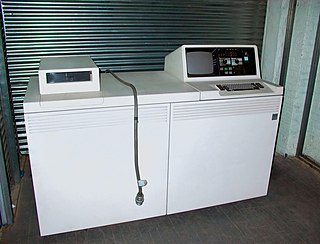Related Research Articles
In computing, a compiler is a computer program that translates computer code written in one programming language into another language. The name "compiler" is primarily used for programs that translate source code from a high-level programming language to a low-level programming language to create an executable program.

In computer science, a microkernel is the near-minimum amount of software that can provide the mechanisms needed to implement an operating system (OS). These mechanisms include low-level address space management, thread management, and inter-process communication (IPC).
In computing and computer programming, exception handling is the process of responding to the occurrence of exceptions – anomalous or exceptional conditions requiring special processing – during the execution of a program. In general, an exception breaks the normal flow of execution and executes a pre-registered exception handler; the details of how this is done depend on whether it is a hardware or software exception and how the software exception is implemented.
This article presents a timeline of events in the history of computer operating systems from 1951 to the current day. For a narrative explaining the overall developments, see the History of operating systems.
William Allan Wulf was an American computer scientist notable for his work in programming languages and compilers.

The System/38 is a discontinued minicomputer and midrange computer manufactured and sold by IBM. The system was announced in 1978. The System/38 has 48-bit addressing, which was unique for the time, and a novel integrated database system. It was oriented toward a multi-user system environment. At the time, the typical system handled from a dozen to several dozen terminals. Although the System/38 failed to displace the systems it was intended to replace, its architecture served as the basis of the much more successful IBM AS/400.
Legion is a computer software system variously classified as a distributed operating system, a peer-to-peer system, metacomputing software, and middleware. It is an object-based system designed to provide secure, transparent access to large numbers of machines, both to computational power and data.

The iAPX 432 is a discontinued computer architecture introduced in 1981. It was Intel's first 32-bit processor design. The main processor of the architecture, the general data processor, is implemented as a set of two separate integrated circuits, due to technical limitations at the time. Although some early 8086, 80186 and 80286-based systems and manuals also used the iAPX prefix for marketing reasons, the iAPX 432 and the 8086 processor lines are completely separate designs with completely different instruction sets.
Capability-based security is a concept in the design of secure computing systems, one of the existing security models. A capability is a communicable, unforgeable token of authority. It refers to a value that references an object along with an associated set of access rights. A user program on a capability-based operating system must use a capability to access an object. Capability-based security refers to the principle of designing user programs such that they directly share capabilities with each other according to the principle of least privilege, and to the operating system infrastructure necessary to make such transactions efficient and secure. Capability-based security is to be contrasted with an approach that uses traditional UNIX permissions and Access Control Lists.

The C.mmp was an early multiple instruction, multiple data (MIMD) multiprocessor system developed at Carnegie Mellon University (CMU) by William Wulf (1971). The notation C.mmp came from the PMS notation of Gordon Bell and Allen Newell, where a central processing unit (CPU) was designated as C, a variant was noted by the dot notation, and mmp stood for Multi-Mini-Processor. As of 2020, the machine is on display at CMU, in Wean Hall, on the ninth floor.

The Cambridge CAP computer was the first successful experimental computer that demonstrated the use of security capabilities, both in hardware and software. It was developed at the University of Cambridge Computer Laboratory in the 1970s. Unlike most research machines of the time, it was also a useful service machine.
Software visualization or software visualisation refers to the visualization of information of and related to software systems—either the architecture of its source code or metrics of their runtime behavior—and their development process by means of static, interactive or animated 2-D or 3-D visual representations of their structure, execution, behavior, and evolution.
End-user development (EUD) or end-user programming (EUP) refers to activities and tools that allow end-users – people who are not professional software developers – to program computers. People who are not professional developers can use EUD tools to create or modify software artifacts and complex data objects without significant knowledge of a programming language. In 2005 it was estimated that by 2012 there would be more than 55 million end-user developers in the United States, compared with fewer than 3 million professional programmers. Various EUD approaches exist, and it is an active research topic within the field of computer science and human-computer interaction. Examples include natural language programming, spreadsheets, scripting languages, visual programming, trigger-action programming and programming by example.
In computer science, capability-based addressing is a scheme used by some computers to control access to memory as an efficient implementation of capability-based security. Under a capability-based addressing scheme, pointers are replaced by protected objects which specify both a location in memory, along with access rights which define the set of operations which can be carried out on the memory location. Capabilities can only be created or modified through the use of privileged instructions which may be executed only by either the kernel or some other privileged process authorised to do so. Thus, a kernel can limit application code and other subsystems access to the minimum necessary portions of memory, without the need to use separate address spaces and therefore require a context switch when an access occurs.
The separation of mechanism and policy is a design principle in computer science. It states that mechanisms should not dictate the policies according to which decisions are made about which operations to authorize, and which resources to allocate.
In computer sciences, the separation of protection and security is a design choice. Wulf et al. identified protection as a mechanism and security as a policy, therefore making the protection-security distinction a particular case of the separation of mechanism and policy principle. Many frameworks consider both as security controls of varying types. For example, protection mechanisms would be considered technical controls, while a policy would be considered an administrative control.
In computer science, protection mechanisms are built into a computer architecture to support the enforcement of security policies. A simple definition of a security policy is "to set who may use what information in a computer system".

The kernel is a computer program at the core of a computer's operating system and generally has complete control over everything in the system. The kernel is also responsible for preventing and mitigating conflicts between different processes. It is the portion of the operating system code that is always resident in memory and facilitates interactions between hardware and software components. A full kernel controls all hardware resources via device drivers, arbitrates conflicts between processes concerning such resources, and optimizes the utilization of common resources e.g. CPU & cache usage, file systems, and network sockets. On most systems, the kernel is one of the first programs loaded on startup. It handles the rest of startup as well as memory, peripherals, and input/output (I/O) requests from software, translating them into data-processing instructions for the central processing unit.
iMAX 432 was an operating system developed by Intel for digital electronic computers based on the 1980s Intel iAPX 432 32-bit microprocessor. The term micromainframe was an Intel marketing designation describing the iAPX 432 processor's capabilities as being comparable to a mainframe. The iAPX 432 processor and the iMAX 432 operating system were incompatible with the x86 architecture commonly found in personal computers. iMAX 432 was implemented in a subset of the original (1980) version of the Ada, extended with runtime type checking and dynamic package creation.

Protection is any measure taken to guard a thing against damage caused by outside forces. Protection can be provided to physical objects, including organisms, to systems, and to intangible things like civil and political rights. Although the mechanisms for providing protection vary widely, the basic meaning of the term remains the same. This is illustrated by an explanation found in a manual on electrical wiring:
The meaning of the word protection, as used in the electrical industry, is no different to that in everyday use. People protect themselves against personal or financial loss by means of insurance and from injury or discomfort by the use of protective clothing. They further protect their property by the installation of security measures such as locks and/or alarm systems.
References
- ↑ Wulf 74 pp. 337–345
- ↑ Siewiorek, Daniel P.; Bell, C. Gordon; Newell, Allen; Mashburn, Henry M. (1982). Computer Structures: Principles and Examples. New York, New York: McGraw-Hill.
- ↑ Levy, Henry M. (1984). Capability-Based Computer Systems (PDF). Digital Press.
- ↑ Wulf, William A.; Harbison, Samual P. Reflections in a pool of processors: An experience report on C.mmp/Hydra (PDF) (Report). p. 945.
- Levin, R.; Cohen, E.; Corwin, W.; Pollack, F.; Wulf, William (November 1, 1975). "Policy/mechanism separation in Hydra". Proceedings of the fifth ACM symposium on operating systems principles. pp. 132–140. doi:10.1145/800213.806531. S2CID 10524544.
- Wulf, William; Cohen, E.; Corwin, W.; Jones, A.; Levin, R.; Pierson, C.; Pollack, F. (June 1974). Hydra: The Kernel of a Multiprocessor Operating System. Vol. 17. pp. 337–345. doi:10.1145/355616.364017. S2CID 8011765. Archived (PDF) from the original on July 1, 2007.